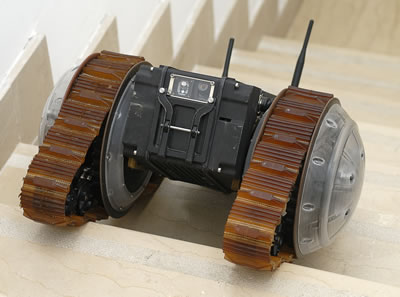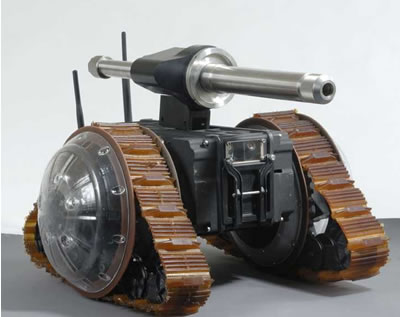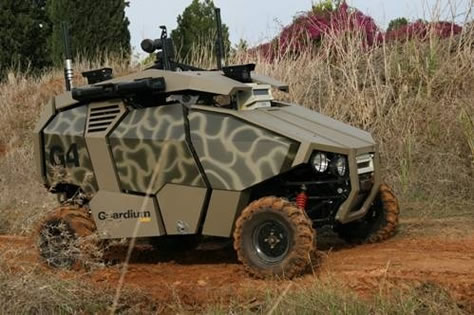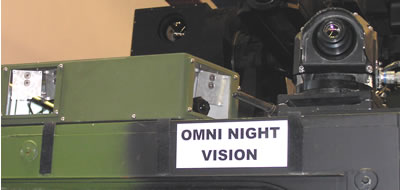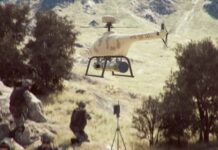The IDF is testing various types of Israeli built unmanned ground vehicles, among them, autonomous navigating robotic vehicles used for security missions and a portable robot designed to support infantry units in urban warfare.
At AUSA Winter symposium, March 2007 Elbit Systems unveiled its lastest UGV known as the Versatile, Intelligent and Portable Robot (VIPeR). This robot is designed to support infantry forces in combat operations. The company developed the prototype version under an Israel Ministry of Defense Resrearch & Development Directorate (DRDD) funding and supplied several systems for evaluations by the IDF.
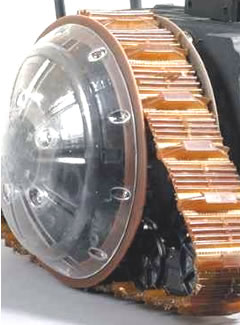 The small robot which has exceptionally high mobility in urban terrain, based on a new, patented integrated wheeled/track system developed by Galileo Mobility Instruments Ltd., powered by two electrical motors, and a “scorpion tail” which elevates the payload and stabilizes the platform, enabling the vehicle to rapidly advance and maintain a steady course of movement over rough terrain. (view a video of the prototype developed by Galileo). In handling obstacles, it is climbing steps or crawling into confined subterranean spaces and caves. With compact dimensions and only about 11 kilograms weight and 30×40 centimeters size (excluding the tail) the new robot can fit into the soldier’s backpack and become a standard equipment of future infantry units. Initial users will most probably be the Special Forces but eventually the IDF plans to field VIPeRs with its infantry platoons. The new robot can be equipped with a standard suite of visual and acoustic sensors and could also mount various effectors, such as a probe, pistol, 9mm mini-Uzi or grenade launcher, or a more capable electronically initiated light weapon (such as a “metal storm” launcher.
The small robot which has exceptionally high mobility in urban terrain, based on a new, patented integrated wheeled/track system developed by Galileo Mobility Instruments Ltd., powered by two electrical motors, and a “scorpion tail” which elevates the payload and stabilizes the platform, enabling the vehicle to rapidly advance and maintain a steady course of movement over rough terrain. (view a video of the prototype developed by Galileo). In handling obstacles, it is climbing steps or crawling into confined subterranean spaces and caves. With compact dimensions and only about 11 kilograms weight and 30×40 centimeters size (excluding the tail) the new robot can fit into the soldier’s backpack and become a standard equipment of future infantry units. Initial users will most probably be the Special Forces but eventually the IDF plans to field VIPeRs with its infantry platoons. The new robot can be equipped with a standard suite of visual and acoustic sensors and could also mount various effectors, such as a probe, pistol, 9mm mini-Uzi or grenade launcher, or a more capable electronically initiated light weapon (such as a “metal storm” launcher.
Unmanned Patrols
Unlike the ambitious US plan to develop and deploy highly autonomous combat robots as part of the FCS program, the Israeli approach is more pragmatic, considering the contributions of such autonomously navigated vehicles in rather limited, mission-specific tasks. These will initially include perimeter security and border patrols and could later be enhanced to specific roles in force protection. In 2006, the IDF conducted an operational test of several unmanned systems, designed to conduct partly autonomous security and patrol missions, as part of border and security operations along the separation zones between Israel, the west bank and Gaza strip. The IDF tested several locally developed systems, including the Guardium, developed by IAI, AvantGuard, developed by Elbit. Under the encouragement of Israel’s MOD the two companies estabished a joint venture called G-NIUS, to harness their combined resources in the UGV field, to offer a cost effective, partly autonomous security system to be based on UGVs, that could relieve some of the pressure from the troops engaged with routine security operations along the country’s borders and securing the perimeters of military bases and installations. By May 2008 the IDF received the first batch of Guardium UGVs scheduled to enter fully operational service along the countrie’s borders by the year’s end. Some defense analysts argue that the abscence of such systems actually triggered the latest Lebanon War in 2006, as Hezbollah guerillas ambushed an IDF patrol killing four soldiers and abducted three from one of the disabled vehicles. Such missions could be effectively performed by unmanned vehicles without putting human soldiers in danger.
UGVs are part of a comprehensive unmanned ground system, based on the Tomcar chassis, a locally built off-road recreational vehicle, equipped with autonomous navigation, and obstacle sensing and avoidance sensors which both feed the control system. The vehicle can travel autonomously from point to point, following a pre-planned mission, employing its video and acoustic sensors to monitor a specific sector, and investigate objects of interest. The vehicle can negotiate various scenarios, with pre-planned responses, with or without human intervention. Such capabilities have already matured at Elbit in other programs. According to Tal Yeshaya, Head of Elbit Ground Systems, Israel, the company could utilize its robotic vision, obstacle detection and avoidance capabilities gained by its subsidiary ElOp subsidiary, through the development of laser radar obstacle avoidance capability for helicopters, which have now matured into the LORD system. When deployed, such robotic vehicles will become “triggers” which could discriminate between innocent and peaceful activities along the perimeter, to hostile or suspicious actions, based on the target’s responses.
Peripheral Vision
As the vehicle performs its mission, its operations are constantly monitored at the command post, where human operators are standing by to intervene when required.
According to Yeshaya, one of the most critical tasks for such system is the creation of “remote situational awareness”, where the remote vehicle can accurately “paint” a realistic and comprehensive situational display. Elbit is introducing several new capabilities to provide such capabilities, including the development of a hemispherical display, based on several video cameras covering 360 degrees. The images generated by each camera are automatically superimposed and “sewed” to create the digital, hemispheric picture which is transmitted back to the command post. Signal processing of a continuous sequence of such images enables more advanced capabilities, such as motion detection, object and obstacle tracking, etc. This hemispheric view also enables the vehicle and operator to point the main payload to investigate specific targets of interest. These capabilities were also implemented by the company in a parallel program, developed to enable tank and AFV crews to maintain full situational awareness while safely operating inside the vehicle, under the armor protection. Similar to the UGV application, this program also integrates sensors, external sensors and remotely operated systems to enable human operators to effectively conduct operations without maintaining direct visual or physical contact with the target.
Related Item: IAI’s Ramta Introduces UGVs for Heavy Engineering Work

